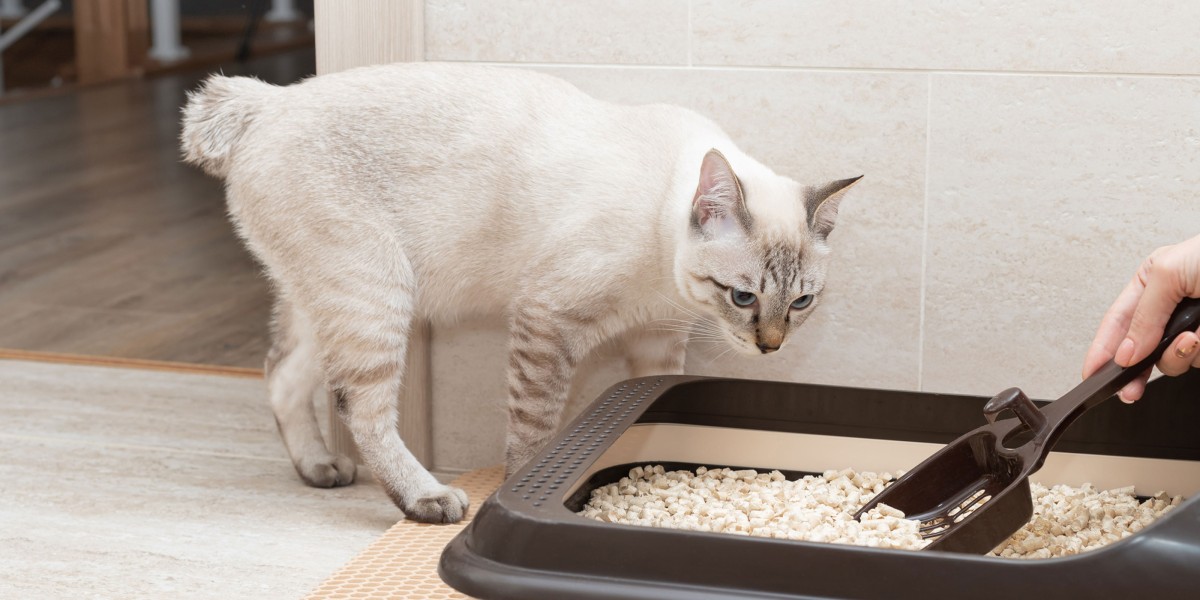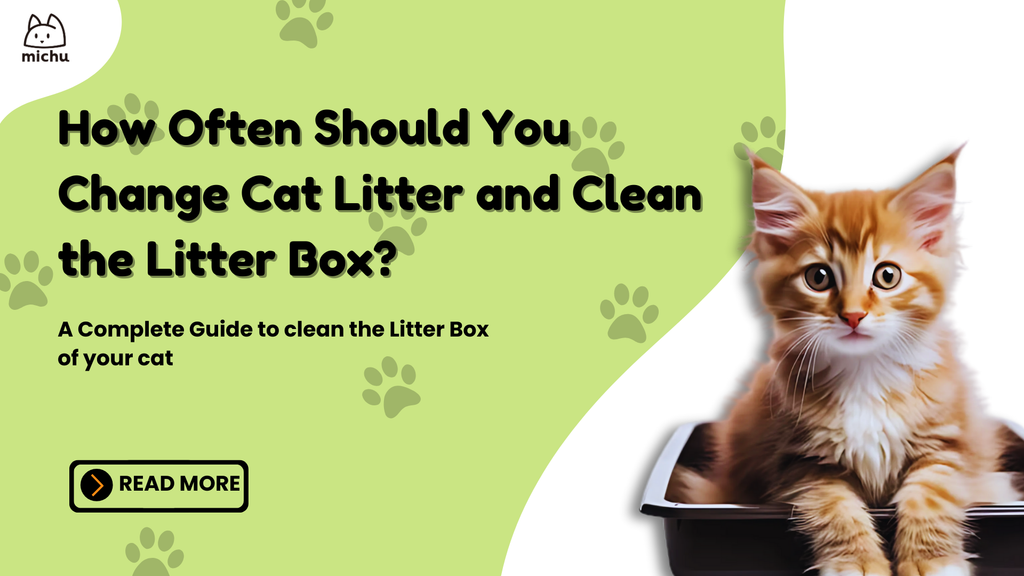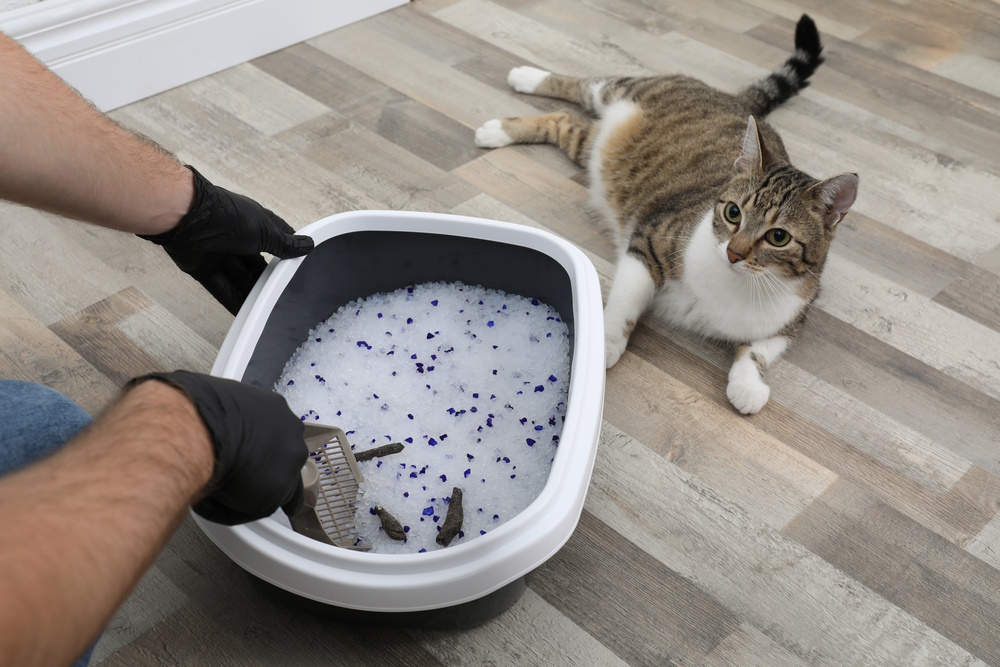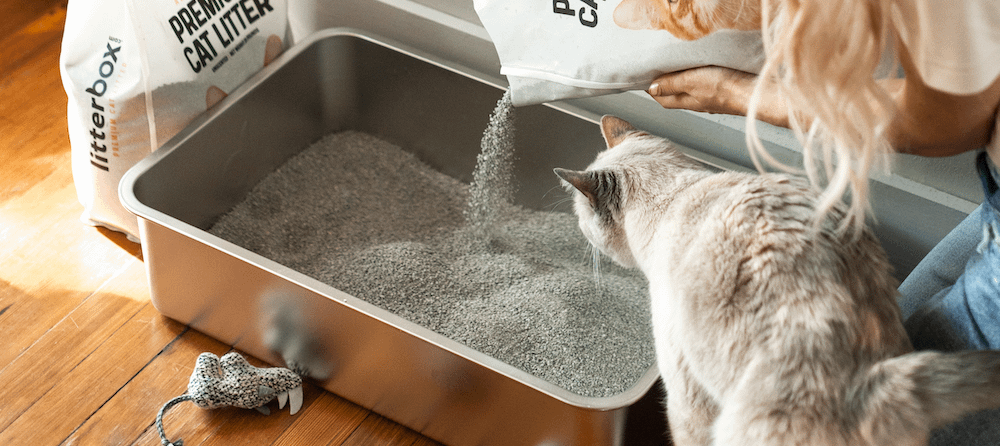Imagine walking into your home after a long day and being greeted by a fresh, clean scent rather than an unpleasant odor. As a cat owner, maintaining a welcoming environment starts with one simple task: changing the cat litter.
But how often should you really be doing this to ensure both your cat’s happiness and your home’s freshness? You might be surprised at how much your cat’s litter habits can affect your home’s atmosphere and even your pet’s health.
Neglecting to change the litter frequently can lead to unpleasant smells, unhappy cats, and potential health issues. On the flip side, changing it too often might be unnecessary and wasteful. You’ll discover the ideal frequency for changing cat litter based on expert advice and cat behavior insights. This knowledge will not only keep your furry friend purring with contentment but also ensure your home remains a pleasant space for you and your guests. Dive in to uncover the secrets of perfect litter maintenance and transform your home into a sanctuary of freshness and harmony.

Credit: www.purina.com
Ideal Frequency For Changing Cat Litter
Finding the right balance for changing your cat’s litter can sometimes feel like a guessing game. How often is often enough? The answer might surprise you. While it might seem like a trivial task, maintaining a clean litter box is crucial for your cat’s health and happiness. A consistent routine is key. Let’s dive into the specifics of how often you should change your cat’s litter for optimal freshness and your feline friend’s comfort.
What Type Of Litter Are You Using?
The type of litter plays a big role in determining how frequently you need to change it. Clumping litter is popular because it allows for easy removal of waste, extending the time between full changes. Non-clumping litter, on the other hand, might require more frequent changes since it doesn’t absorb moisture as effectively.
Are you using a natural or silica-based litter? These types can absorb odors longer, meaning a full change might not be necessary as often. Knowing your litter type can help you set a realistic schedule.
Consider The Number Of Cats
Do you have multiple cats? If so, your litter-changing schedule will need to accommodate the added use. More cats mean more waste, which can quickly lead to a smelly situation if not managed properly.
In households with several cats, it’s often recommended to change the litter twice a week to maintain cleanliness and prevent odor build-up. Each cat should ideally have its own litter box to minimize stress and territorial disputes.
Pay Attention To Odor And Appearance
Your nose knows best! If you notice an unpleasant smell, it’s likely time for a change. Even if your calendar says otherwise, trust your senses to guide you.
Visual cues are just as important. If the litter looks damp or clumped together, it’s a sign that it’s time for a refresh. Clean litter is essential for preventing health issues in your cat and keeping your home smelling fresh.
Establish A Routine
Creating a routine helps ensure you don’t forget this essential task. Consider setting reminders on your phone or marking your calendar to keep track of when you last changed the litter.
Consistency is comforting for cats. They thrive on routine, and knowing their litter box is consistently clean can provide them with a sense of security.
Listen To Your Cat
Has your cat started avoiding the litter box? This could be their way of telling you something is amiss. Cats are particular about cleanliness and may refuse to use a dirty box.
Pay attention to their behavior and adjust your cleaning schedule accordingly. A happy cat is one that feels comfortable in their environment.
How often do you change your cat’s litter? Could adjusting your routine make a difference for your furry friend? Consider these factors and see if you can find a new rhythm that works for both you and your cat.
Factors Influencing Litter Change
Cats need clean litter boxes to stay healthy. The type of litter, number of cats, and box size affect how often to change it. Generally, scoop daily and change entirely every week to maintain cleanliness and reduce odors.
Changing cat litter is a task that every cat owner faces. Yet, how often should you actually do it? The answer depends on various factors. Each element plays a role in maintaining a clean and healthy environment for your feline friend. By understanding these factors, you can make informed decisions about your cat’s litter needs.Type Of Litter
The type of litter you choose significantly influences how often you need to change it. Clumping litter typically lasts longer because it makes it easier to remove waste daily. On the other hand, non-clumping litter might require a full change more frequently, as it doesn’t isolate waste as effectively. Consider experimenting with different types of litter to see which one suits your lifestyle best. Some brands offer enhanced odor control, meaning you might not need to change the litter as often. Keep an eye on your cat’s reaction; some cats are picky about their litter and may prefer one type over another.Number Of Cats
The more cats you have, the more often you’ll need to change the litter. Each cat contributes more waste, which can lead to odors and unsanitary conditions if not managed properly. For a single cat, a weekly litter change might suffice, but two or more cats might necessitate twice-weekly changes. Think about your cats’ personalities. Are they territorial about their litter box? Multiple cats using the same box might mean faster accumulation of waste, prompting you to change the litter more often. Consider whether a second litter box could alleviate some of this pressure.Size Of Litter Box
The size of the litter box is another important factor. A larger box can hold more litter and thus absorb more waste over time. This means you might not need to change the litter as frequently compared to a smaller box. However, a bigger box doesn’t always mean better. Your cat needs to be comfortable using it. A cramped or overly large box can deter them from using it altogether. Have you ever noticed your cat refusing to use its box? It might be time to rethink the size or placement of the litter box. Isn’t it surprising how something as simple as litter management can have so many nuances? By paying attention to these factors, you can ensure a healthier, happier environment for your cat. How often do you find yourself changing the litter, and which factors have you noticed make the biggest impact?Signs It’s Time To Change The Litter
Maintaining a clean litter box is essential for your cat’s health. But how do you know when it’s time to change the litter? Recognizing the signs can ensure your feline friend stays happy and healthy. Let’s explore the indicators that suggest it’s time for a refresh.
Odor Indicators
A strong smell is a clear signal the litter needs changing. If the litter box emits a noticeable odor, it’s time for a clean. Fresh litter should have a neutral scent. A persistent smell means waste has built up. This can cause discomfort for your cat.
Cat Behavior Changes
Cats are creatures of habit. Any change in their behavior can indicate a problem. If your cat stops using the litter box, investigate. They might start eliminating outside the box. This could mean the litter is too dirty. Watch for signs of distress. Scratching excessively at the litter may also be a clue.
Visual Clues
Take a look at the litter box. Is there visible waste? Clumps or discoloration are signs of overdue cleaning. Litter should appear fresh and clean. A messy appearance suggests it’s time for a change. Regular inspection can prevent buildup. A clean box keeps your cat content.
Best Practices For Litter Maintenance
Maintaining your cat’s litter box is crucial for their health and your home’s cleanliness. Keeping the litter fresh and clean can prevent unpleasant odors and make your feline friend happy. Best practices for litter maintenance involve daily attention, monthly cleaning, and smart disposal. Each step is essential, but how often do you really need to change that litter?
Daily Scooping Routine
Think of scooping as your morning coffee ritual. It’s quick and sets the tone for the day. Scooping daily removes waste and keeps odors at bay. It also helps you monitor your cat’s health. Changes in waste can signal health issues, so pay attention while you scoop. A clean box encourages your cat to use it regularly, avoiding accidents around the house.
Monthly Deep Cleaning
Monthly deep cleaning is like a spa day for the litter box. Dump out all the old litter and scrub the box with warm water and mild soap. This prevents bacteria build-up and lingering smells. Remember to rinse thoroughly to avoid soap residue. A clean box is more inviting for your cat, ensuring they feel comfortable using it.
Proper Disposal Methods
Ever wondered what to do with the used litter? Proper disposal is key to maintaining a clean environment. Avoid flushing litter down the toilet as it can cause plumbing issues. Instead, use a sealed trash bag and dispose of it in the garbage bin. Some areas offer recycling programs for certain types of litter. Check local regulations to see what’s best for your community.
Keeping a clean litter box is more than just a chore; it’s about creating a healthy habitat for your pet. How do you ensure your litter maintenance routine is effective? Share your tips and experiences in the comments below!
Choosing The Right Litter For Your Cat
Choosing the right litter for your cat is crucial not only for their comfort but also for maintaining a clean and odor-free home. Cats can be picky, and their litter preferences might surprise you. Understanding the different types of cat litter will help you make an informed decision that suits both you and your feline friend.
Clumping Vs. Non-clumping
Clumping litter makes cleaning easier. When your cat uses the litter box, the moisture causes the litter to form solid clumps. These are easy to scoop out, leaving the rest of the box clean and fresh. Non-clumping litter absorbs moisture but doesn’t form clumps, so you need to change it more frequently. If you prefer minimal daily maintenance, clumping might be the way to go.
Natural Vs. Synthetic Options
Consider what materials you and your cat prefer. Natural litters are made from materials like corn, wheat, or wood. They often have fewer chemicals, which some cats find more comfortable. Synthetic options like clay or silica gel offer strong odor control and are widely available. Weigh the benefits of natural materials against the convenience of synthetic ones.
Dust-free Choices
Dust can be a significant issue for both you and your cat, particularly if anyone in your home has allergies. Dust-free litters minimize airborne particles, making them a healthier choice. Many brands offer low-dust formulas in both clumping and non-clumping varieties. Wouldn’t you prefer a cleaner and more breathable environment for your cat?
Finding the right cat litter is like finding the perfect pair of shoes—you need comfort and functionality. Your cat’s preferences matter, so observe how they react to different litter types. Choosing wisely will keep both your kitty and your home happy.

Credit: michupet.com
Tips For Encouraging Cat Hygiene
Changing cat litter regularly is vital for hygiene. Scoop waste daily and replace litter weekly to prevent odor. Clean the litter box completely once a month for optimal cleanliness.
Encouraging good hygiene habits in your cat is crucial for their health and your peace of mind. A clean and inviting litter box can make a significant difference in how your cat feels about their bathroom space. While changing cat litter regularly is essential, there are additional strategies you can implement to promote better hygiene practices for your feline friend.Placement Of Litter Box
Choosing the right spot for your cat’s litter box is more important than you might think. Cats prefer a quiet, low-traffic area where they can feel safe. Avoid placing the box near their food or water bowls, as cats naturally dislike these areas being too close together. In my home, I discovered that a corner in the laundry room worked wonders. It provided the privacy my cat needed, yet was easy for me to access and clean. Where have you placed yours?Regular Monitoring
Regularly checking the litter box helps you stay on top of your cat’s hygiene. Scoop the litter daily to remove waste and monitor any changes in their habits. A sudden refusal to use the litter box might indicate a health issue or dissatisfaction with the litter type. Create a routine for checking the box, perhaps when you first wake up or just before bed. This habit not only benefits your cat but also keeps odors at bay, ensuring a fresher home environment.Training Techniques
Training your cat to maintain good litter habits isn’t as daunting as it sounds. Positive reinforcement can go a long way. Reward your cat with treats or affection when they use the box correctly. If accidents happen, clean the area thoroughly to remove any scent traces that might attract them back. Consistency is key. Have you tried any training techniques that have worked well? By focusing on these practical steps, you foster an environment that supports your cat’s hygiene. This not only keeps them healthy but also enhances your bond with them. What changes will you make today to encourage better cat hygiene?
Credit: www.catster.com
Frequently Asked Questions
How Often Are You Supposed To Fully Change Cat Litter?
Fully change cat litter every 1-2 weeks. Scoop daily to maintain cleanliness and prevent odors. Regular cleaning keeps your cat healthy. Adjust based on the number of cats and litter type. Always follow specific litter instructions for best results.
What Happens If You Don’t Change Cat Litter Often?
Failing to change cat litter often leads to odors and bacteria buildup. Cats may avoid dirty litter boxes, causing health issues. Regular cleaning maintains a fresh environment and promotes feline hygiene.
How Often Should You Change Cat Litter?
Cat litter should be changed regularly to maintain cleanliness. Typically, it’s recommended to change it every 1 to 2 weeks. However, the frequency depends on the number of cats and type of litter used. Clumping litter may require less frequent changes, while non-clumping needs more regular changes.
How Do I Know When To Change Cat Litter?
Signs that indicate it’s time to change cat litter include odor, wetness, and visible waste. If the litter box smells or appears dirty, it’s time for a change. Regular scooping helps, but complete changes ensure hygiene. Monitoring these signs will help maintain a clean environment for your cat.
Conclusion
Changing cat litter regularly keeps your home fresh and your cat happy. Clean litter reduces bad odors and health risks. Cats prefer clean litter boxes, which encourages proper habits. Check the litter box daily to see if it needs changing.
Scoop waste every day to maintain cleanliness. Replace the entire litter weekly for best results. Use your judgment; some cats need more frequent changes. Regular cleaning ensures a healthy environment for your cat. Keep your feline friend comfortable with a clean, pleasant space.
Prioritizing cleanliness benefits both you and your pet.
